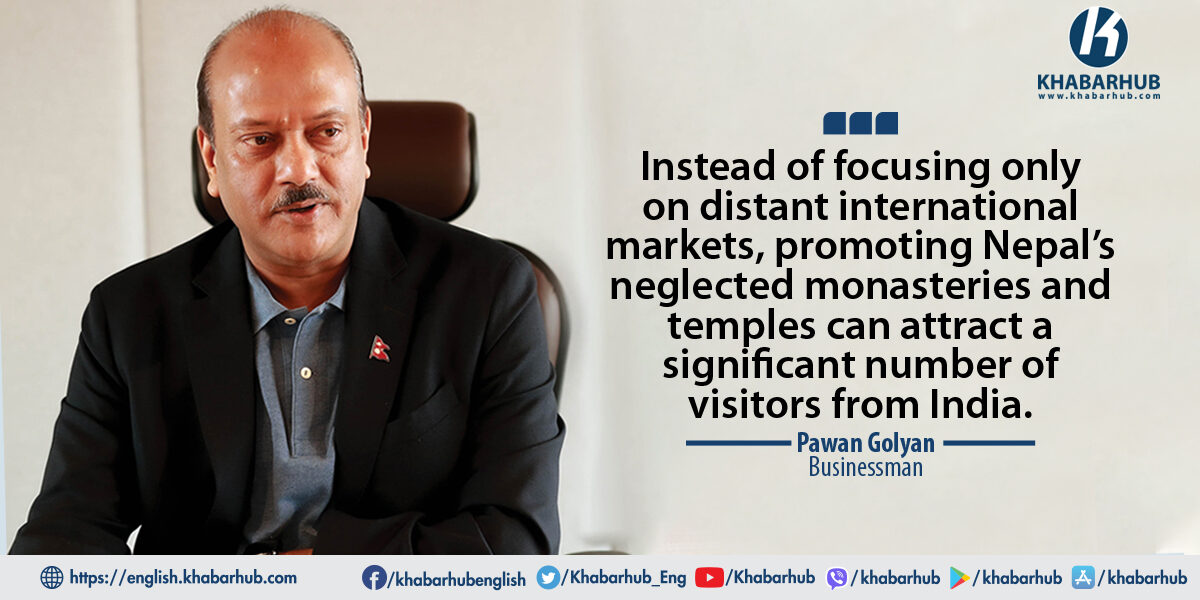While we organize various tourism programs abroad, it would be more effective to host these initiatives within Nepal.
By inviting media and people from different countries and showcasing what Nepal has to offer, the impact would be much greater.
Promoting Nepal’s tourism requires attracting visitors from abroad. A good example of this is when Indian Prime Minister Narendra Modi visited Muktinath Temple.
Following his visit, the number of tourists there increased significantly. Likewise, while Pashupatinath receives many visitors, promoting lesser-known places like Doleshwor Mahadev could attract an additional five hundred thousand tourists to Kathmandu.
Nepal is home to five Ganesh temples, many of which are not well known. Some of these temples, once visited on foot, remain hidden gems.
If embassies and international media help in promoting these lesser-known attractions, more tourists will come to Nepal.
If India supports Nepal’s agricultural potential, the sector will develop rapidly. Alone, Nepal faces many challenges, but by welcoming Indian collaboration, we can overcome issues with exports and other hurdles.
Instead of focusing only on distant international markets, promoting Nepal’s neglected monasteries and temples can attract a significant number of visitors from India.
The Hotel Association Nepal (HAN), the Nepal Tourism Board (NTB), and local hoteliers are all eager to welcome more tourists to Nepal.
The budget is already allocated, and if we can attract Indian tourists now, we can later tap into the Buddhist tourism market. However, we must first make plans and take action.
Adventure tourism is also gaining traction among Indian visitors. We should organize various adventure tourism destinations across Nepal, using media to amplify our efforts.
Additionally, we need to make airports in key locations operational. Specifically, Bhairahawa and Pokhara airports should be fully functional.
Lifting the ban on Indian citizens landing directly at Bhairahawa airport would make Lumbini more accessible and connect our Buddha Circuit, which would significantly increase tourist arrivals.
Currently, hotels in Pokhara and Lumbini are underperforming. Attracting Indian tourists to these areas could make these hotels more viable, modernize their facilities, and increase profitability.
Connecting Nepal to the Indian market could bring substantial benefits. For instance, Nepali ghee is in high demand in India, yet it is exported through illegal channels.
If we can brand products like shilajit and honey, it will help market Nepali products effectively.
Yam, grown in Nepal’s eastern hills, also has great potential. With proper cultivation, it can provide farmers with good income at low cost.
To realize this potential, we urgently need agricultural processing industries to bring these products to the international market.
Such efforts cannot be achieved by a single entity alone. Government support, as well as cooperation from other sectors, is essential.
Embassies can act as a vital link to facilitate this process. By working together, we can create opportunities for over 200,000 farmers to earn income in just six months and export these products to India.
To maximize the value of our agricultural products, we should invite Indian brands to Nepal, partner with them to process our products, and then export them to global markets.
Nepali products, sold under the “Made in Nepal” label, can fetch premium prices because they are in demand worldwide.
Currently, Nepal exports large quantities of cardamom to India, but we are not receiving fair prices.
Nepal’s government has invested in the East-West Railway project, but without collaboration with India, this effort could prove ineffective.
We export it at Rs. 600, while it’s traded in Nepal for Rs. 2500. This disparity is affecting farmers, and the lack of visibility in export figures only exacerbates the problem.
India’s Agriculture Minister, a down-to-earth individual, could help address these issues. If we invite him to Nepal and organize a program, it could lead to significant solutions.
If India supports Nepal’s agricultural potential, the sector will develop rapidly. Alone, Nepal faces many challenges, but by welcoming Indian collaboration, we can overcome issues with exports and other hurdles.
Once we form strong partnerships with Indian brands, many of the challenges we currently face will disappear.
This collaboration also provides Nepali industries with an opportunity to learn and evolve, driving a revolution in our own sectors.
Nepal’s government has invested in the East-West Railway project, but without collaboration with India, this effort could prove ineffective.
Instead, investing in agriculture, with India’s support, would yield better results for the country’s future.
(Edited excerpt of the views shared by businessman Pawan Golyan at an interaction program on Nepal-India bilateral relations, jointly organized by the Institute for Strategic and Socio-Economic Research (ISSR) and Khabarhub on Monday.)









Comment